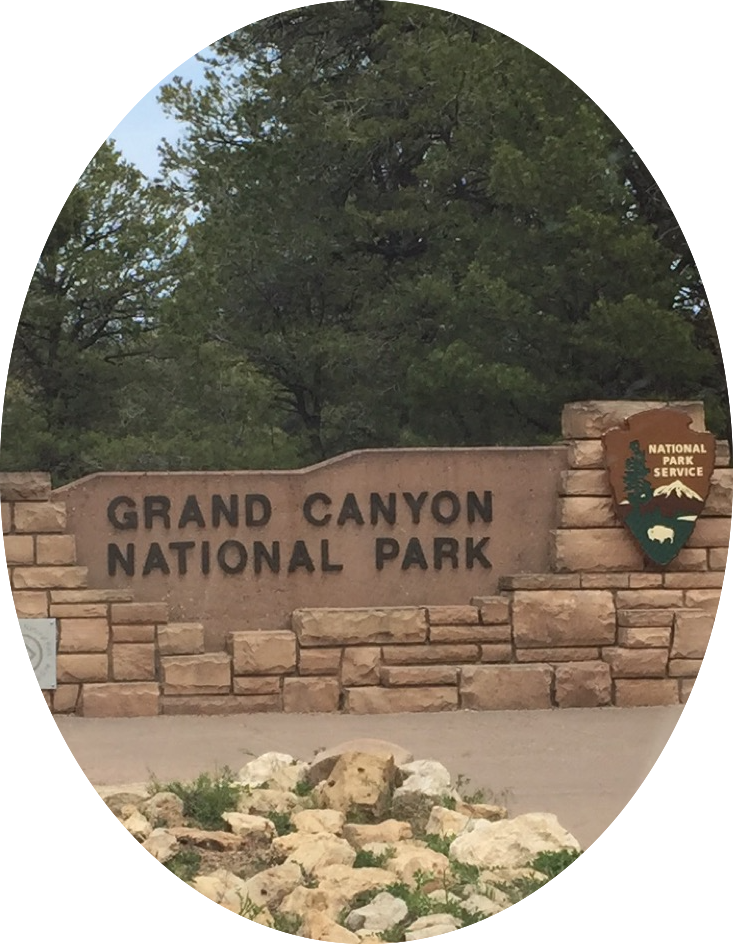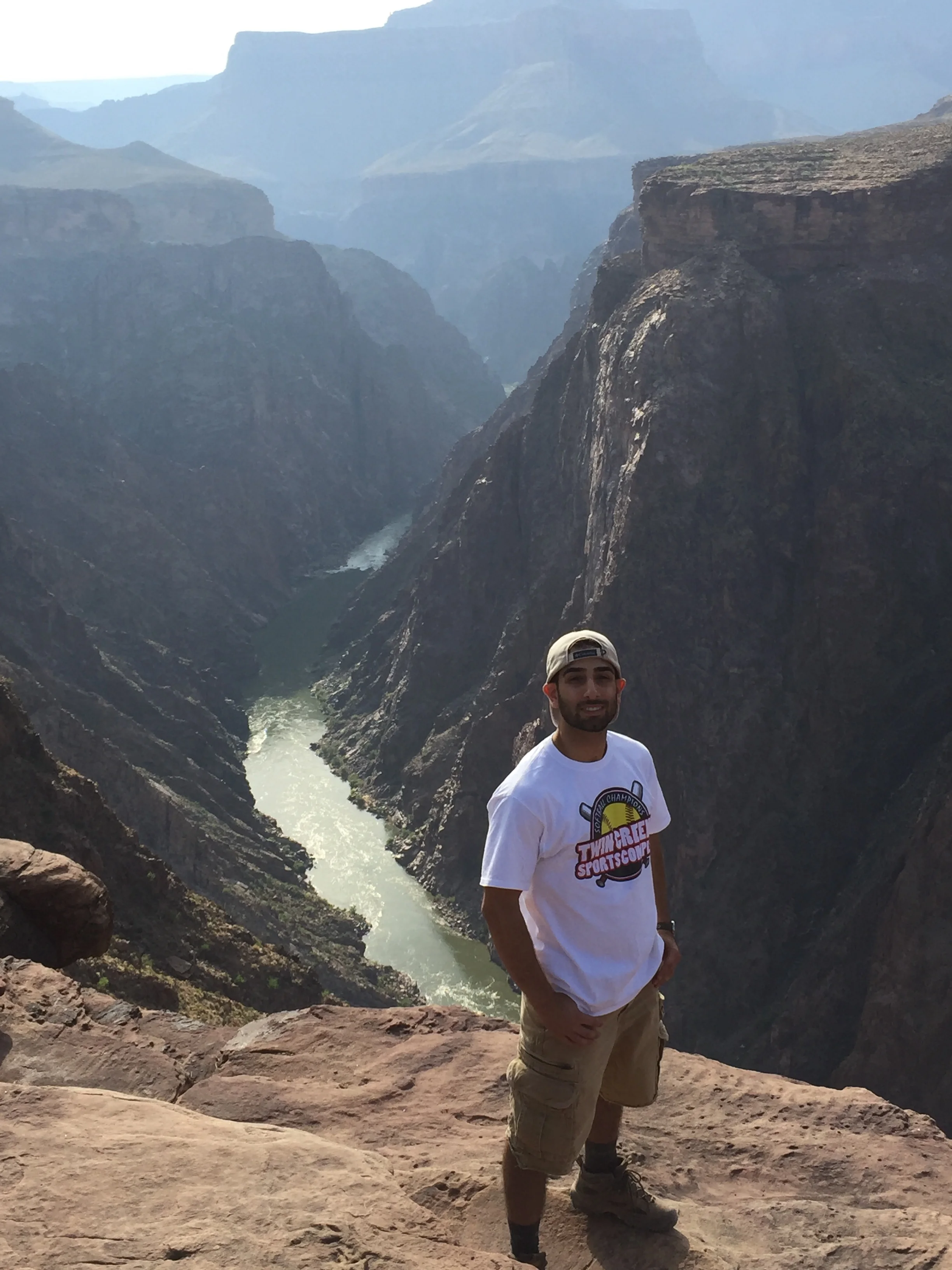Grand Canyon National Park
Camping & Hiking Guide
Entrance to Grand Canyon National Park
One of Seven Wonders of the Natural World
Everyone knows what the Grand Canyon looks like, we've all seen pictures. But do you know how the canyon was formed? The Grand Canyon is the result of millions of years of erosion by the Colorado River. Mother nature put in all that work for us, and now it's time for us to appreciate this unique geological feature.
You feel overwhelmed when you stand at the edge of the canyon. 277 miles long, up to 18 miles wide at times, one mile deep. Seeing it in person puts magnitude in perspective. You stop and think, "wow, size does matter".
Most people visit the South Rim of the park. The South Rim is home to famous trails and vantage points as seen on postcards. The north, east, and west rims are less visited, but still provide plenty of activities and sightseeing opportunities. If you've always wanted to visit but never have, now is your chance to go.
Planning and Preparing to Visit and Hike Grand Canyon National Park
This is the view of the Colorado River after hiking a few hours to Plateau Point on the Bright Angel Trail
There's plenty of auto-touring around the canyon, and there is also the rim trail, which is mostly flat. But if you'd like to serious hiking actually into the canyon, make sure to train beforehand. Be in shape. During our trip we hiked from the top of the canyon all the way down, very close to the river. We left a little too late in the day and our hike took us all day and past sunset.
We hiked about 12 miles round trip, with 6,000 feet in elevation gain and loss. We ascended and descended a total of roughly 500 flights of stairs.
If you would like to stay overnight at the Grand Canyon, you can find information about camping here. If you want to bring your RV, we reviewed Harvest Host, which is a new way to park your RV in unique places around the country. The campgrounds are very nice. Reserve a camping spot specifically for the South Rim here. Other lodging options near the South Rim include Airbnbs, and hotels. Click here for Grand Canyon Lodging Options.
If you're prepping for a trip to the Grand Canyon, some items you might want to consider bringing include: A 3 liter Camelbak, a hat, polarized sunglasses, sunscreen, exercise clothes according to the weather, and good trail or hiking shoes. Do not wear jeans and sneakers! Also, don't forget your tent and camping gear, and again, bring lots of water.
Grand Canyon camping and hiking checklist
Don't forget these camping and hiking essentials. This is not an all inclusive packing list, but represents gear that I found to be most important during my trip.
Lantern, headlamp, or flashlight
Hat, polarized sunglasses, and sunscreen
Proper hiking boots or trail shoes
Trail snacks, water, and firewood
How to get to Grand Canyon National Park
If you live far from the Grand Canyon, the closest airports are Grand Canyon Airport in Tusayan (2 miles from park entrance) and Flagstaff Pulliam Airport (1 hour south). Other airports within driving distance include Phoenix (3 hours south) and Las Vegas (4 hours). Driving from Los Angeles to the Grand Canyon takes 7 hours.
Another awesome way to get to the Grand Canyon is by train! You can take a historic train from Williams, Arizona, to the South Rim of Grand Canyon. Click here for more information or to book your train tickets.
There are also many tours available from Las Vegas.
Things to do in Grand Canyon National Park
The best thing to do in Grand Canyon is hiking but there are so many activities to take advantage of in Grand Canyon that you probably won't have time for them all. There's mule trips, bicycle rentals, and whitewater river trips, to name a few.
Hiking is the most popular activity. The Rim Trail is the easiest hike in this National Park, but there are many other day hikes to choose from. There is backcountry backpacking as well.
We hiked on Bright Angel's Trail, and would really recommend it. It's challenging and beautiful. Along the way, you'll take epic pictures, stop by the Three Mile Resthouse (restrooms, water), pass by Indian Garden Campground (campsites, water) , and then either take the Plateau Point Trail to Plateau Point, which is where I'm standing in the picture a little bit up the page, or keep hiking along the Bright Angel Trail to get to the river. Time it so that you're back at the top before sunset, especially if you don't have lights. Here are two documents from the National Park Service on the Bright Angel Trail:
If you decide to go hiking down into the canyon, please be careful. The hiking is extremely strenuous and not for the inexperienced. We saw missing person signs along the way and also someone was passed out along the trail with medical professionals administering an IV to him.
South Rim of the Grand Canyon
Bring plenty of water, food, and a headlamp and/or flashlight, because there is a chance you won't make it back up to the top/rim before sunset. It's cool to get back to the top at night, and look down into the canyon. You see snakes of people's headlamps throughout the canyon, slowly ascending back up.
After exhausting yourself in the South Rim of the Grand Canyon, consider visiting the north, east, or west rims. The North Rim has camping options and is only open seasonally. The east is home to Horseshoe Bend. The west is host to the Grand Canyon Skywalk.
Tips for Visiting Grand Canyon National Park
You can take a helicopter tour of the Grand Canyon
There's lots to do in Phoenix, including watching an Arizona Diamondbacks baseball game
There's lots to do in Las Vegas
Zion National Park is close, challenge yourself with the Angel's Landing hike
Visit Grand Canyon today!
But be warned, after you head back home, the walking trail behind your house won't seem like much anymore. You realize that what you once thought was large is actually small and what you thought was small is actually really small. This is what makes exploring the outdoors so great.
Going on adventures in National Parks really puts things into perspective. This is what also makes the western side of the U.S. so damn awesome. It's nice to sometimes stop and think about how much greatness is right in our backyard.
If you still have time after visiting the Grand Canyon, consider visiting the other National Parks nearby such as Zion National Park. You can tour multiple National Parks and Monuments within driving distance, which is known as the Grand Circle. Las Vegas and Phoenix aren't too far.
Grand Canyon FAQ
When is the best time to visit the Grand Canyon? Not too cold or hot...and to avoid the busiest tourist times.
The busiest times at the Grand Canyon are during the spring, summer, and fall. There are less people in the early spring or late fall. The South Rim is the most popular destination for tourists. It gets so busy at the South Rim that the National Park Service has created a South Rim Crowds Survival Guide. It has tips on the best time to arrive and how to avoid crowds. Have a great trip!
Is Grand Canyon National Park open in December?
The South Rim is open all year round, 365 days a year. South Rim is open for camping, lodging, and dining 365 days a year, even during the winter. The North Rim is only open from May to October, including North Rim lodging, camping, and visitor services. During winter, Highway 67 to the North Rim get shuts down a lot. More information can be found here.



